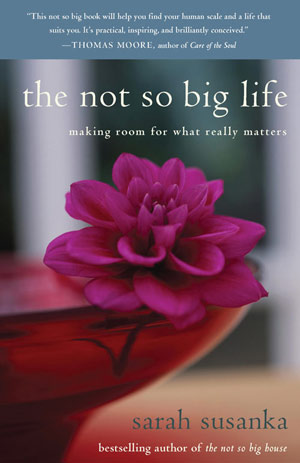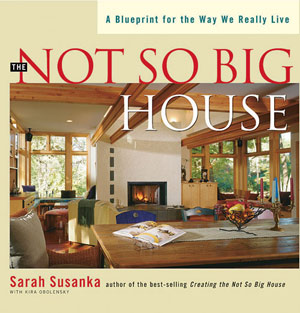One on One With . . . Sarah Susanka

The irony of the situation is hard to miss: A disorganized freelance writer is running late for an interview, misses her turn, can’t be reached on her cell phone because she accidentally grabbed her husband’s and can’t call to say she’s late because the number she needs is in the notebook she left at home, somewhere near the business cards she forgot. Luckily, she is on her way to chat with Sarah Susanka, architect and author of The Not So Big House series, including her most recent book, The Not So Big Life, which focuses on ridding life of unnecessary clutter and overwhelming to-do lists, to make time for what really matters.
Sarah Susanka (after much apologizing and catching of breath by Meg Sparwath): Well, it seems like The Not So Big House would be a good book for you.
Meg Sparwath: Yes, I am definitely your target audience. In the introduction of The Not So Big Life, you wrote that you had an epiphany one night while reading in bed. You said you had been “asleep at the wheel while barreling down the road of life on cruise control,” until that moment.
SS: Yes, although I was a successful architect, I needed a change. I was not pursuing my other passion, which was writing. So I carved out a little time to write each day.
MS: And here you are seven books later. How can the rest of us live a not so big life?
SS: The first step is identifying what inspires you. Then you figure out what’s not working in your life. In the book I use a house as a metaphor for life. Your life is not unlike your home. Some things work well, and others don’t. Do you use your dining room? Is the first thing you see when you walk into your house the laundry room? The same goes for life. Do you feel obligated to attend events that you don’t enjoy? You have to remove the unwanted clutter in your life. This can be done by making small, simple changes.
MS: Tell me about your first book, The Not So Big House. Are you telling us to move into smaller homes? Or is that, too, about creating more personal spaces in our homes?
SS: What I am saying is that bigger is not always better. Instead of spending your budget on square footage, use it toward creating a house that reflects your lifestyle and personality. So many homes contain wasted space—formal dining rooms that are rarely used and soaring two-story entryways that feel cold and impersonal.
MS: Reading The Not So Big House made me want to install window seats and get rid of the giant garden tub we never use in our master bathroom.
SS: Exactly. It is the small details that make a home special. A window seat is a wonderful, light-filled place to read, think or take a nap. There are so many ways to include storage space without adding square footage—built-in cabinets could be built under a window seat in the place of your garden tub. Look at this restaurant (The Globe). These vertical shelves have been thought out—it’s a well-designed space.
MS: How do people go about building a well-designed home?
SS: The book tells people how to choose the right professionals for the job. There’s also a home professionals directory on the Web site notsobighouse.com.
MS: So now we have no excuse for not being comfortable in our homes.
SS: Right. Think of it like music. A well-designed home is like well-composed music. It transports you to another place.








